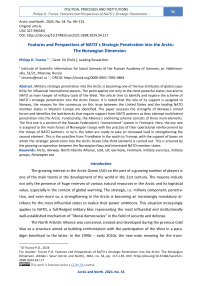Features and Perspectives of NATO`s Strategic Penetration into the Arctic: The Norwegian Dimension
Автор: Trunov P.O.
Журнал: Arctic and North @arctic-and-north
Рубрика: Political processes and institutions
Статья в выпуске: 54, 2024 года.
Бесплатный доступ
Military-strategic penetration into the Arctic is becoming one of the key attributes of global capability for influential international players. The point applies not only to the most powerful states, but also to NATO as main keeper of military tools of the West. The article tries to identify and explore the scheme of NATO`s strategic penetration into the Arctic Ocean. It is noted that the role of its support is assigned to Norway, the reasons for the consensus on this issue between the United States and the leading NATO member states in Western Europe are identified. The paper assesses the strengths of Norway’s armed forces and identifies the bottlenecks that require support from NATO partners as they attempt multilateral penetration into the Arctic. Functionally, the Alliance’s anchoring scheme consists of three main elements. The first one is a section of the Russian Federation’s “containment” system in Finnmark. Here, the key role is assigned to the main forces of Norwegian troops with the practice of their operational reinforcement by the troops of NATO partners. In turn, the latter are ready to take an increased load in strengthening the second element. This is the coastline from Trondheim in the south to Tromsø, with the support of bases on which the strategic penetration into the Arctic Ocean (the third element) is carried out. This is ensured by the growing co-operation between the Norwegian Navy and interested NATO member states.
Arctic, Norway, North Atlantic Alliance, USA, UK, Germany, Finnmark, military exercises, military groups, Norwegian sea
Короткий адрес: https://sciup.org/148329511
IDR: 148329511 | УДК: 327.59(045) | DOI: 10.37482/issn2221-2698.2024.54.117
Список литературы Features and Perspectives of NATO`s Strategic Penetration into the Arctic: The Norwegian Dimension
- Bratersky M.V. Sources of the New Cold War: Main Features of the Systemic Conflict in the XXI Cen-tury. Current Problems of Europe, 2020, no. 1 (105), pp. 15–31. DOI: https://doi.org/10.31249/ape/2020.01.01
- Novikova O.N. Britain's Fourth Afghan War. Current Problems of Europe, 2022, no. 4 (116), pp. 213–233. DOI: https://doi.org/10.31249/ape/2022.04.09
- Arzamanova T.V. Some Aspects of German Strategic Planning in Indo-Pacific Region Facing the Re-turn of Great Power Rivalry. Current Problems of Europe, 2022, no. 4 (116), pp. 258–284. DOI: https://doi.org/10.31249/ape/2022.04.11
- Zhuravel V.P., Timoshenko D.S. The Russian Arctic, Sanctions Pressure and Geopolitical Instability. Arctic and North, 2022, no. 49, pp. 105–124. DOI: https://doi.org/10.37482/issn2221-2698.2022.49.105
- Paul M. Arktische Seewege. Berlin, Deutsches Institut für Internationale Politik und Sicherheit SWP. 2020. 44 s. DOI: https://doi.org/10.18449/2020S14
- Paul M. Die Arktische Sicherheitspolitik der USA. SWP-Aktuell, 2023, no. 26, 8 p. DOI: https://doi.org/10.18449/2023A26
- Kuchinskaya M.E. The Arctic in Focus of U.S. and NATO Attention and Russia’s Security Interests. National Strategy Issues, 2020, no. 1, pp. 68–89.
- Raikov Yu.A. Russia and the USA in the Arctic: From Competition to Confrontation. USA & Canada: Economics, Politics, Culture, 2022, no. 1, pp. 39–52. DOI: https://doi.org/10.31857/S2686673022010035
- Dzyuban V.V. Norway’s Arctic Policy in the 21st Century. Arkhont, 2019, no. 6, pp. 4–9.
- Konyshev V.N., Sergunin A.A. Contemporary Military Strategy of Norway in the Arctic and the Secu-rity of Russia. National Interests: Priorities and Security, 2017, vol. 13, no. 2, pp. 353–368. DOI: https://doi.org/10.24891/ni.13.2.353
- Zhuravel V.P. Norway’s Arctic Strategy and Security Issues. Scientific and Analytical Herald of IE RAS, 2021, no. 5, pp. 23–30. DOI: https://doi.org/10.15211/vestnikieran520212330
- Istomin I.A. Management of Security Commitments in Asymmetric Alliances. The Case of Russia. In-ternational Trends, 2021, no. 1, pp. 26–55. DOI: https://doi.org/10.17994/IT.2021.19.1.64.1
- Zolotarev V.A., ed. Istoriya voennoy strategii Rossii [The History of Russia's Military Strategy]. Mos-cow, Poligrafresursy Publ., 2000, 592 p. (In Russ.)
- Nikitin A.I. Trends of Military-Political Development in Europe and of Military-Technical Cooperation between the EU Member States. Current Problems of Europe, 2020, no. 4 (108), pp. 53–74. DOI: https://doi.org/10.31249/ape/2020.04.03
- Istoriya Vtoroy mirovoy voyny 1939–1945 (v 12 tomakh). Tom 3 [The History of the Second World War 1939-1945 (In 12 Volumes). Vol. 3]. Moscow, Voenizdat Publ., 1974, 498 p. (In Russ.)
- Istoriya Vtoroy mirovoy voyny 1939–1945 (v 12 tomakh). Tom 8 [The History of the Second World War 1939-1945 (In 12 Volumes). Vol. 8]. Moscow, Voenizdat Publ., 1977, 536 p. (In Russ.)
- Shtemenko S.M. General'nyy shtab v gody Voyny. Kniga 2 [The General Staff during the War. Vol. 2]. Moscow, Izdatel'stvo Minoborony SSSR Publ., 1974, 510 p. (In Russ.)
- Lauch Z. Osnovy operativnogo myshleniya NATO. Retrospektivnyy analiz operativnogo myshleniya 80-kh gg. i otsenka perspektiv razvitiya: monografiya [The Foundations of NATO Operational Think-ing. A Retrospective Analysis of Operational Thinking in the 80s and Assessment of Development Prospects]. Moscow, Tula, Akvarius Publ., 2022, 268 p. (In Russ.)
- Todorov А.А. Svalbard in the Context of Arctic Security. Arctic and North, 2020, no. 39, pp. 127–143. DOI: https://doi.org/10.37482/issn2221-2698.2020.39.127


